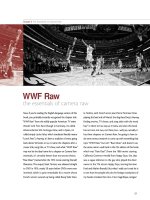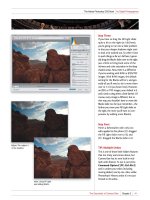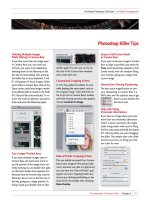The Adobe Photoshop CS5 Book for Digital Photographers part 15 ppsx
Bạn đang xem bản rút gọn của tài liệu. Xem và tải ngay bản đầy đủ của tài liệu tại đây (972.22 KB, 10 trang )
ptg
121Chapter 5How to Resize and Crop Photos
The Adobe Photoshop CS5 Book for Digital Photographers
Step Six:
Now press the Esc key to remove your
cropping border. Press Tab, then the
F key twice to hide all of Photo shop’s
panels and menus, plus this centers your
photo onscreen surrounded by solid
black (as seen here). That’s it—you’re in
“Lights Out cropping mode” because you
made any cropped-away area solid black,
which matches the black full-screen area
surrounding your photo. So, try it your-
self—get the Crop tool again, drag out
a cropping border, then drag any one of
the cropping handles inward and you’ll
see what I mean. Pretty sweet, eh? When
you’re done cropping, press Return (PC:
Enter), then press the letter F once more
to leave full-screen mode, then press the
Tab key to bring your panels, menus, and
Toolbox back.
TIP: Deciding Not to Crop
If you drag out a cropping border and
then decide you don’t want to crop the
image, you can either press the Esc key
on your keyboard, click on the “No!”
symbol in the Options Bar, or just click
on a different tool in the Toolbox, which
will bring up a dialog asking if you want
to crop the image. Click on the Don’t
Crop button to cancel your crop.
Download from www.wowebook.com
ptg
122
Chapter 5 How to Resize and Crop Photos
The Adobe Photoshop CS5 Book for Digital Photographers
If you’re outputting photos for clients, chances are they’re going to want
them in standard sizes so they can easily find frames to fit their photos.
If that’s the case, you’ll find this technique handy, because it lets you
crop any image to a predetermined size (like 5x7", 8x10", and so on).
Cropping to a
Specific Size
Step One:
Let’s say our image measures roughly
17x11", and we want to crop it to be a
perfect horizon tal 10x8". First, press the
C key to get the Crop tool, and up in
the Options Bar on the left, you’ll see
Width and Height fields. Enter the size
you want for the width, followed by the
unit of measurement you want to use
(e.g., “in” for inches, “px” for pixels, “cm”
for centimeters, “mm” for millimeters,
etc.). Next, press the Tab key to jump
over to the Height field and enter your
desired height, again followed by the
unit of measurement.
Step Two:
Click within your photo with the Crop
tool and drag out a cropping border.
You’ll notice that as you drag , the border
is constrained to a horizontal shape, and
once you release the mouse button, no
side points are visible—only corner points.
Whatever size you make your border, the
area within that border will become a
10x8" photo.
SCOTT KELBY
Download from www.wowebook.com
ptg
123Chapter 5How to Resize and Crop Photos
The Adobe Photoshop CS5 Book for Digital Photographers
Step Three:
After your cropping border is onscreen,
you can reposition it by moving your
cursor inside the border (your cursor will
change to an arrow). You can now drag
the border into place, or use the Arrow
keys on your keyboard for more precise
control. When it looks right to you, press
Return (PC: Enter) to finalize your crop,
and the area inside your cropping border
will be 10x8". (I made the rulers visible by
pressing Command-R [PC: Ctrl-R], so
you could see that the image measures
exactly 10x8".)
TIP: Clearing the Width and Height
Once you’ve entered a Width and Height
in the Options Bar, those dimensions will
remain in place until you clear them. To
clear the fields (so you can use the Crop
tool for freeform cropping to any size),
just go up in the Options Bar and click
on the Clear button (while you have the
Crop tool active, of course).
COOLER TIP: Cropping to
Another Photo’s Size
If you already have a photo that is the
exact size and resolution that you’d like
to apply to other images, you can use
its settings as the crop dimen sions. First,
open the photo you’d like to resize, and
then open your ideal-size-and-resolution
photo. Get the Crop tool, and then in
the Options Bar, click on the Front Image
button. Photoshop will automatically
input that photo’s dimensions into the
Crop tool’s Width, Height, and Resolution
fields. All you have to do is crop the other
image, and it will share the exact same
specs as your ideal-size photo.
Download from www.wowebook.com
ptg
124
Chapter 5 How to Resize and Crop Photos
The Adobe Photoshop CS5 Book for Digital Photographers
Creating Your
Own Custom
Crop Tools
Although it’s more of an advanced technique, creating your own custom tools isn’t
complicated. In fact, once you set them up, they will save you time and money.
We’re going to create what are called “tool presets.” These tool presets are a series of
tools (in this case, Crop tools) with all our option settings already in place. So we’ll
create a 5x7", 6x4", or whatever size Crop tool we want. Then, when we want to
crop to 5x7", all we have to do is grab the 5x7" Crop tool preset. Here’s how:
Step One:
Press the letter C to switch to the Crop
tool, and then go under the Window
menu and choose Tool Presets to bring
up the Tool Presets panel. You’ll find that
five Crop tool presets are already there.
(Make sure that the Current Tool Only
checkbox is turned on at the bottom
of the panel, so you’ll see only the Crop
tool’s presets, and not the presets for
every tool.)
Step Two:
Go up to the Options Bar and enter the
dimensions for the first tool you want
to create (in this example, we’ll create
a Crop tool that crops to a wallet-size
image). In the Width field, enter 2. Then
press the Tab key to jump to the Height
field and enter 2.5. Note: If you have
the Rulers set to Inches under the Units
section in Photoshop’s Units & Rulers
Preferences (Command-K [PC: Ctrl-K]),
when you press the Tab key, Photo shop
will automatically insert “in” after your
numbers, indicating inches.
Download from www.wowebook.com
ptg
125Chapter 5How to Resize and Crop Photos
The Adobe Photoshop CS5 Book for Digital Photographers
Step Three:
In the Tool Presets panel, click on the
Create New Tool Preset icon at the bottom
of the panel (to the left of the Trash icon).
This brings up the New Tool Preset dialog,
in which you can name your new preset.
Name it, click OK, and the new tool is
added to the Tool Presets panel. Continue
this process of typing in new dimensions
in the Crop tool’s Options Bar and clicking
on the Create New Tool Preset icon until
you’ve created custom Crop tools for the
sizes you use most. Make sure the name
is descriptive (for example, add “Portrait”
or “Landscape”). If you need to change the
name of a preset, just double-click directly
on its name in the panel, and then type in
a new name.
Step Four:
Chances are your custom Crop tool pre-
sets won’t be in the order you want them,
so go under the Edit menu and choose
Preset Manager. In the resulting dialog,
choose Tools from the Preset Type pop-up
menu, and scroll down until you see the
Crop tools you created. Now just click-and-
drag them to wherever you want them to
appear in the list, and then click Done.
Step Five:
Now you can close the Tool Presets
panel because there’s an easier way to
access your presets: With the Crop tool
selected, just click on the Crop icon on
the left in the Options Bar. A pop-up
menu of tools will appear. Click on a
preset, drag out a cropping border, and
it will be fixed to the exact dimensions
you chose for that tool.
Download from www.wowebook.com
ptg
126
Chapter 5 How to Resize and Crop Photos
The Adobe Photoshop CS5 Book for Digital Photographers
Step One:
Go under the File menu and choose New.
When the New dialog appears, click on
the Preset pop-up menu to reveal the
list of preset types, and choose Photo.
Then click on the Size pop-up menu to
see the preset sizes, which include 2x3",
4x6", 5x7", and 8x10" in both portrait and
landscape orientation. The only problem
with these is that their resolution is set
to 300 ppi by default. So, if you want a
different size preset at less than 300 ppi,
you’ll need to create and save your own.
Step Two:
For example, let’s say that you want a 5x7"
set to landscape (that’s 7" wide by 5" tall).
First choose Photo from the Preset pop-
up menu, then choose Landscape, 5x7
from the Size pop-up menu. Choose your
desired Color Mode (below Resolution)
and Color Profile (under Advanced), and
then enter a Resolution (I entered 212 ppi,
which is enough for me to have my image
printed on a high-end printing press).
Once your settings are in place, click
on the Save Preset button.
Photoshop’s dialog for creating new documents has a pop-up menu with a list of
preset sizes. You’re probably thinking, “Hey, there’s a 4x6", 5x7", and 8x10"—
I’m set.” The problem is there’s no way to switch the resolution of these presets
(so the Portrait, 4x6 will always be a 300 ppi document). That’s why creating
your own custom new document sizes is so important. Here’s how:
Custom Sizes for
Photographers
Download from www.wowebook.com
ptg
127Chapter 5How to Resize and Crop Photos
The Adobe Photoshop CS5 Book for Digital Photographers
Step Three:
This brings up the New Document Preset
dialog. In the Preset Name field, enter your
new resolution at the end of the size. You
can turn on/off the checkboxes for which
parameters you want saved, but I use the
default setting to include everything (bet-
ter safe than sorry, I guess).
Step Four:
Click OK and your new custom preset will
appear in the New dialog’s Preset pop-up
menu. You only have to go through this
once. Photoshop will remember your
custom settings, and they will appear in
this Preset pop-up menu from now on.
Step Five:
If you decide you want to delete a preset,
it’s simple—just open the New dialog,
choose the preset you want to delete from
the Preset pop-up menu, and then click
the Delete Preset button. A warning dia-
log will appear asking you to confirm the
delete. Click Yes, and it’s gone!
Download from www.wowebook.com
ptg
128
Chapter 5 How to Resize and Crop Photos
The Adobe Photoshop CS5 Book for Digital Photographers
Step One:
Open the digital camera image that you
want to resize. Press Command-R (PC:
Ctrl-R) to make Photoshop’s rulers visible.
As you can see from the rulers, the photo
is about 59" wide by 39" high.
Step Two:
Go under the Image menu and choose
Image Size (or press Command-Option-I
[PC: Ctrl-Alt-I]) to bring up the Image Size
dialog. Under the Document Size section,
the Resolution setting is 72 ppi. A resolu-
tion of 72 ppi is considered “low resolution”
and is ideal for photos that will only be
viewed onscreen (such as Web graphics,
slide shows, and so on), but it’s too low to
get high-quality results from a color inkjet
printer, color laser printer, or for use on a
printing press.
If you’re used to resizing scans, you’ll find that resizing images from digital cameras
is a bit different, primarily because scanners create high-res scans (usually 300 ppi
or more), but the default settings for many digital cameras produce an image that
is large in physical dimensions, but lower in pixels-per-inch (usually 72 ppi). The
trick is to decrease the physical size of your digital camera image (and increase its
resolution) without losing any of its quality. Here’s the trick:
Resizing Digital
Camera Photos
SCOTT KELBY
Download from www.wowebook.com
ptg
129Chapter 5How to Resize and Crop Photos
The Adobe Photoshop CS5 Book for Digital Photographers
Continued
Step Three:
If we plan to output this photo to any
printing device, it’s pretty clear that we’ll
need to increase the resolution to get
good results. I wish we could just type
in the resolution we’d like it to be in the
Resolution field (such as 200 or 240 ppi),
but unfortunately this “resampling” makes
our low-res photo appear soft (blurry)
and pixelated. That’s why we need to
turn off the Resample Image check box
(it’s on by default). That way, when we
type in a Resolution setting that we need,
Photoshop automatically adjusts the
Width and Height of the image down in
the exact same proportion. As your Width
and Height come down (with Resample
Image turned off), your Res olution goes
up. Best of all, there’s absolutely no loss
of quality. Pretty cool!
Step Four:
Here I’ve turned off Resample Image and
I entered 240 in the Resolution field for
output to a color inkjet printer. (I know,
you probably think you need a lot more
resolution, but you don’t. In fact, I never
print with a resolution higher than 240
ppi.) This resized my image to nearly
12x18" so it’s just about perfect for print-
ing to my Epson Stylus Photo R2880
printer, which makes up to 13x19"-sized
prints—perfect!
Download from www.wowebook.com
ptg
130
Chapter 5 How to Resize and Crop Photos
The Adobe Photoshop CS5 Book for Digital Photographers
Step Five:
Here’s the Image Size dialog for our
source photo, and this time I’ve lowered
the Resolution setting to 180 ppi. (Again,
you don’t need nearly as much resolu-
tion as you’d think, but 180 ppi is pretty
much about as low as you should go
when printing to a color inkjet printer.)
As you can see, the Width of my image
is no longer 59"—it’s now almost 24".
The Height is no longer 39"—now it’s
almost 16". Best of all, we did it without
damaging a single pixel, because we
were able to turn off Resample Image,
which normally, with things like scans,
we couldn’t do.
Step Six:
When you click OK, you won’t see the
image window change at all—it will
appear at the exact same size onscreen—
but look at the rulers. You can see that
it’s now about 15" high by about 23" wide.
Resizing using this technique does three
big things: (1) it gets your physical dimen-
sions down to size (the photo now fits
easily on an 16x24" sheet); (2) it increases
the resolution enough so you can out-
put this image on a color inkjet printer;
and (3) you haven’t softened, blurred,
or pixelated the image in any way—the
quality remains the same—all because
you turned off Resample Image. Note: Do
not turn off Resample Image for images
that you scan on a scanner—they start as
high-res images in the first place. Turning
Resample Image off like this is only for
low-res photos taken with a digital camera.
Download from www.wowebook.com









